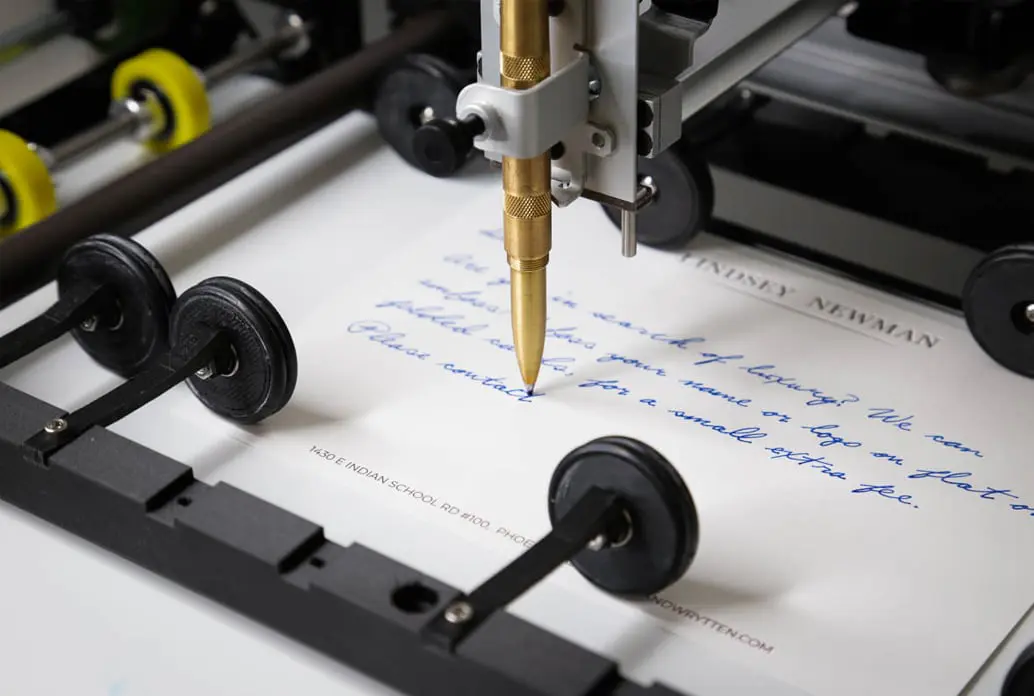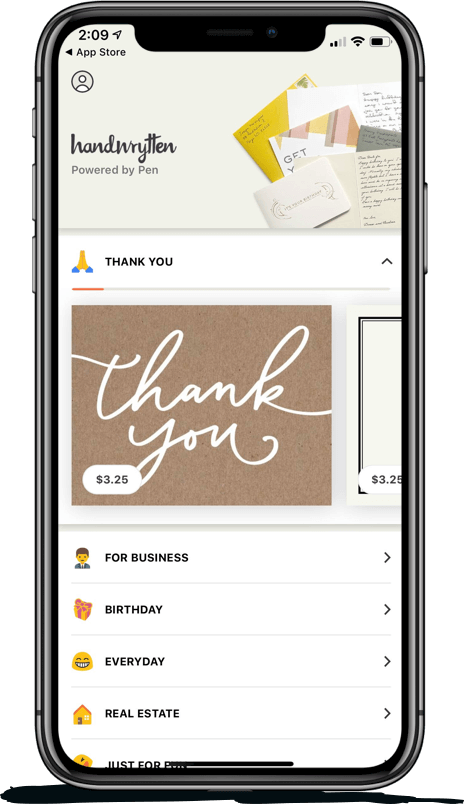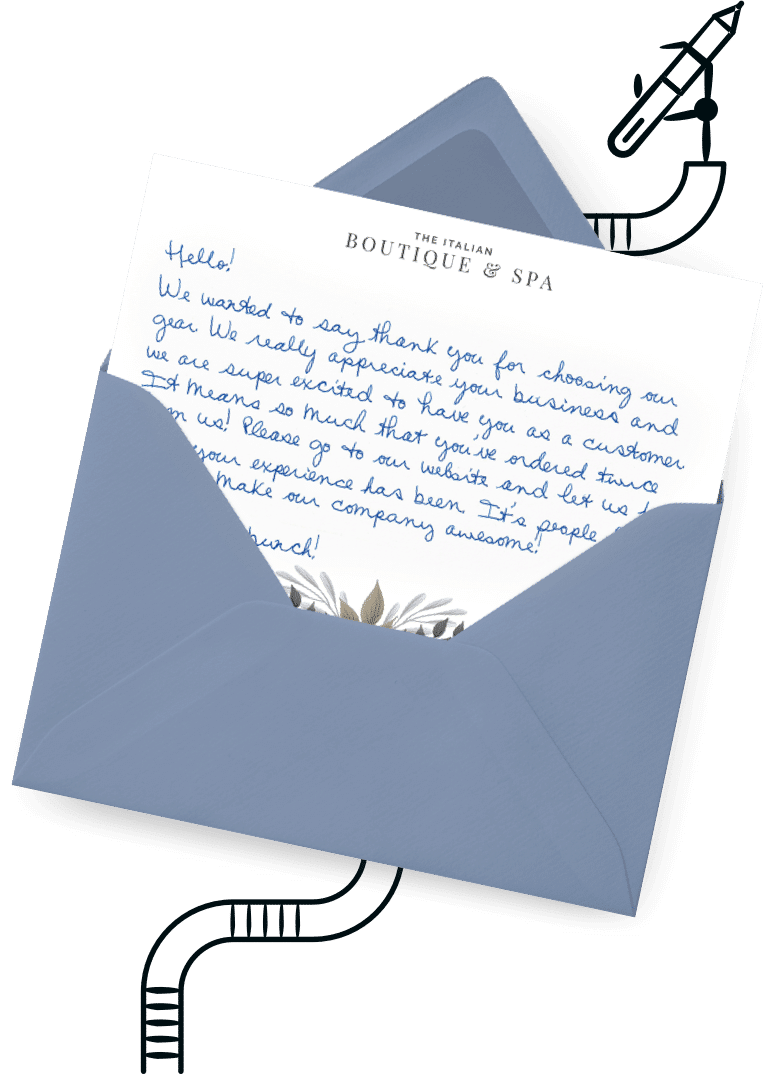
9280 S. Kyrene Rd.
Suite 134
Tempe, AZ 85284
Phone: +1 (888) 284-5197
Email: contact@handwrytten.com



You have been subscribed. Thank you!
Personalization has been around for some time, and for years, businesses have been adding a personal touch to their direct mail to strengthen customer relationships, improve the customer experience, and make customers feel valued. Today, it’s a common practice to greet customers at the door and use their first name in an email or a greeting card. However, these strategies are no longer sufficient for attracting new and engaging current customers. Marketers are faced with ever-increasing customer sophistication and advances in technology that call for greater ingenuity when designing marketing campaigns.
To compete with a myriad of other businesses for customers’ attention, marketers need to get more personal with their images, offers, landing pages, and graphics. With the help of modern tools, you can take advantage of organic customer databases that provide information on current and potential customers. The data you’ve collected yourself is indispensable for creating customized marketing campaigns, leading to improved response and a boost in ROI.
Since we are bombarded with a multitude of stimuli, we’ve become extremely selective about what we give our attention to and what we choose to read or discard. According to the Direct Marketing Association research, the response rate for a piece of direct mail that we receive from a company that we know is only 18.4 percent. The response rate is only 4.4 percent for mail from unknown organizations. If only the familiarity factor by itself can triple the response, imagine what you can achieve with personalized direct mail. To give you an idea of the personalization impact, consider some of the stats compiled by Handwrytten:
• Sixty-four percent of Americans prefer handwritten communication to electronic forms.
• Handwritten envelopes are 300 percent more likely to be opened compared to printed envelopes.
Take marketing to the next level with personalized notes.
Now that you have the facts, let’s examine the exact reasons behind personalization effectiveness. Understanding how it works and why it makes customers respond will make it clear how to use these tools for your marketing campaigns.
As multiple studies report, people feel special when they receive a personalized piece of mail and pay more attention to such correspondence. When you use a person’s name in a conversation, you increase your chances of that person connecting with you. The same is true for direct mail. When people see their names in a letter, for example, they feel an affinity with the sender and are more willing to respond.
With personalization, you can tailor your message to a specific person. When you use the information you’ve collected from customers based on their purchasing history, you are able to make your offers more appealing. Unlike standard audience segmentation, personalization goes a level higher and allows you to customize your offers based on each recipient’s preferences, demographics, and past shopping behaviors.
To preserve our sanity, our brains constantly filter irrelevant information and focus our attention on what matters to us. Filtering is how we are able to hear the person next to us and have a conversation in a busy bar with loud music. In essence, personalization takes advantage of this unique brain capability for selective attention. We tap into people’s interests, thus grabbing their attention and making them feel special.
When people receive personalized content, they have an easier time making a decision and acting on it since they feel less overwhelmed with information. To see it in action, remember how frustrated it feels trying to pick a movie to watch on a Friday night and going through the list of popular choices on your favorite movie database, for example. The process is much more satisfying and quicker when, for example, Netflix offers you a list of choices compiled based on your viewing history.
Mail personalization can help you improve the response rate. As you customize your message according to customers’ needs and desires, not only do you make people feel special but you also better align your message with each individual’s personality. As a result, people are more inclined to respond to your offer.
When it comes to personalization, companies often worry about making mistakes. Thus, they avoid complex personalization and stick to tried-and-true techniques such as using a customer’s name in their marketing mail.
However, with contemporary tools, even sophisticated personalization is no longer as intricate as it seems. As long as you are diligent at maintaining a detailed database with customer information, you can easily personalize each mailpiece using special software. In the age of data and technology, marketers have no excuse not to take full advantage of these tools. By compiling data through traditional methods and with the help of content analytics tools, marketers can reach unprecedented levels of personalization of direct mail campaigns.
Simply adding a customer’s name is no longer sufficient for attracting customers. Effective personalization takes into account many details, such as a customer’s hobbies, lifestyles, and beliefs. Each element of the mailpiece must be carefully selected or designed to incorporate as much information as possible. Even images that go on the envelope can contain relative data and reflect a person’s interests, for example.
Personalization can take various shapes and forms and be limited only by your imagination. To get you started, explore some tips for adding a personal touch to your next direct mail marketing campaign:
1. Images: Visuals can set the mood and compel a customer to open mail and read the message. You want to have images that appeal to each recipient. Consider selecting images based on the location of customers to make content familiar and relevant to their everyday lives. Also, you can customize images according to the person’s hobbies and preferences. For example, a mailpiece for a cat lover may have a photo of a cute kitten, while the one intended for a traveler may do better with an image of an airplane.
2. Offer: A powerful personalization technique involves tailoring your offer to a customer’s needs. If you are successful at targeting a person’s specific needs, you are more likely to get a response. Collect data about your customers’ interactions with your business as well as personal information (such as whether they have children or own a house) and then use this intelligence to customize your marketing mail. If you operate a restaurant, you may advertise it to families with children as a kid-friendly establishment. A retail store may appeal to homeowners by featuring on their flyers home decor items or certain maintenance services they offer.
3. Copy: The copy is always personalized to customers and uses their names and any other relevant information. Try being thoughtful when creating the copy and beware of it being too long as it may distract your recipients from reading it.
4. Form: If your offer includes a form for customers to fill out, you can prefill certain fields with their names, addresses, and phone numbers. By doing so, you make it easier for customers to complete the form, thus increasing the response rate.
5. PURLs: You can also personalize your online content and direct customers to a PURL (personalized URL). Besides targeting customers with customized content, another benefit of PURLs is that they allow you to better track your users’ behaviors.
6. Gender: Don’t forget about differences in perception of the same product between men and women. You should adjust your content based on gender to make it appealing to men and women alike.
7. Reminder: If the product you sell needs to be renewed or repurchased at regular time intervals, your personalized campaigns can include the date of customers’ last purchase or expiration date to remind them and create a sense of urgency.
8. Industry: Note the industries that your customers represent. They all may have different reasons for purchasing your products and services, so consider using variable data printing to take customization to the next level and align your message with their reasons.
Depending on your marketing goals and budget, you can choose from several types of direct mail. You may send different marketing materials to potential and existing customers. You may also designate separate mail types for low- and high-value products. Before choosing which type to send, make sure to keep in mind that snail mail delivers at various times based on a few factors.
Classic packages: This most common and effective type of direct mail is usually sent in an envelope and includes a letter and a response device. It may also have flyers, brochures, and other materials. A classic package is one of the most expensive direct mail options because it includes much material, which could be costly to print and ship. Classic packages are typically sent to potential customers. The letter included in the package gives the recipient the first impression of your company. Since it may be the most important piece of the package, the letter needs to be customized properly.
Postcards: Postcards are great for short messages to target specific consumers. As an effective marketing tool, postcards can be sent as reminders and special offers. Appearing in various sizes, postcards can vary in their production and shipping costs. Larger postcards may have a stronger visual impact; however, they will also be more expensive.
Newsletters: Typically, newsletters are meant for existing clientele. They allow companies to share news and information about sales and updates. The printing and mailing of the actual letter will be fairly inexpensive, although you may need to invest some time and effort to create a publication with the right balance of news, information, and sales material.
Brochures: Brochures bridge the gap between postcards and letters. They can have the appeal of cards and still have room for your message. You can customize them with bullets and tear-off coupons and offers. You can make them casual, serious, colorful, or elegant.
Catalogs: Consider catalogs if you sell multiple products. You can include your best sellers in the front to get people’s attention fast. Catalogs are a great option to introduce customers to your brand, products, or services. They also work well with current customers as they keep them up-to-date with your newest products.
Self-mailers: Self-mailers are sent without envelopes and formed out of larger pieces of paper with print on both sides. Self-mailers are great for attracting prospective customers because they can include more information about the business and visuals compared to cards. You can easily make them with a computer and a printer or a copy machine. Self-mailers are one of the more economical direct mail options, but they could look cheap compared to other types of marketing materials. If you have the resources, consider making them professionally.
Dimensional mailers: This type of direct mail is regarded as the most effective, with a nearly 100 percent open rate. With dimensional mailers, you provide customers with an in-depth and exclusive overview of the brand. However, the costs of creating dimensional mailers are significantly higher. Besides the printed material, dimensional mailers also include a product sample or promotional premium. With dimensional mailers, you can create a very unique and customized experience for your customers. Because of the costs associated with this type of direct mail marketing, it is best to reserve dimensional mailers for marketing higher price point products to high-value customers. For this reason, dimensional mailers are most common in B2B marketing.
With many marketing resources and technology, you can create elaborate and personalized marketing campaigns like never before. The results are well worth the time and effort invested in mastering new tools and techniques and setting up new marketing systems. Personalized direct mail reaches much deeper than landing sales; it helps you customize the shopping experience for each customer. If your customers feel special and appreciated, they will remember your brand and will be more inclined to return to your business in the future. Essentially, by personalizing your communications with customers, you build your brand awareness and solidify your customer loyalty.


Scale your handwritten outreach, creating positive impressions and long lasting bond.
Sign Up Today!


Over 100 designs to choose from or design your own. Our online card customizer makes it simple.
Check Out Our Cards!





